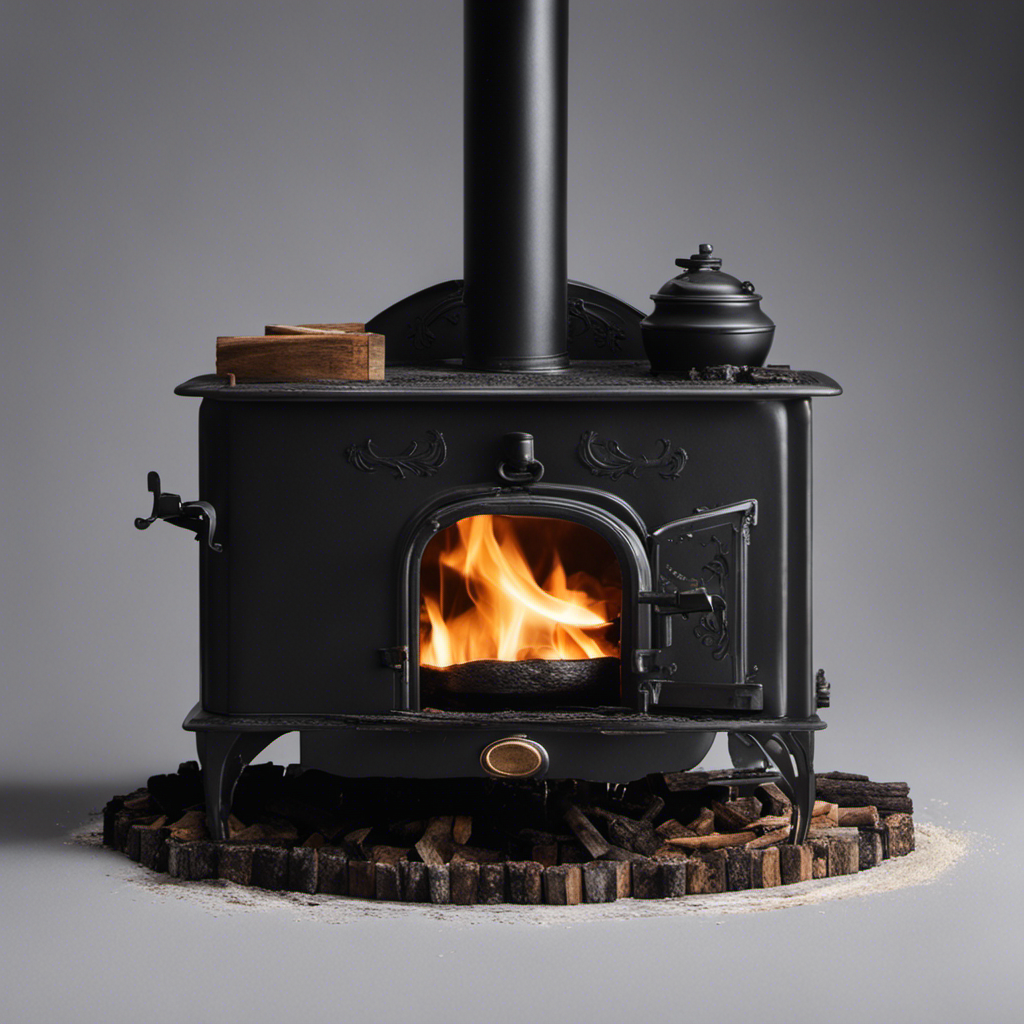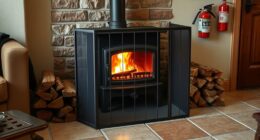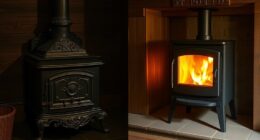Were you aware that consistently clearing out the ash tray of your wood stove could enhance its efficiency by as much as 25%?
In this article, I’ll guide you through the step-by-step process of safely and efficiently emptying your wood stove with an ash tray.
From choosing the right tools to cleaning and maintaining the tray, you’ll learn everything you need to keep your wood stove running smoothly and effectively.
So let’s get started and make your wood stove maintenance a breeze!
Key Takeaways
- Use the appropriate tools, such as a sturdy metal shovel, metal bucket with a tight-fitting lid, heat-resistant gloves, and an ash container, for safe and effective ash removal.
- Ensure that the fire is completely out and the stove is cool to the touch before emptying the ash tray to prevent accidental fires or injuries.
- Use a metal ash shovel or specialized ash vacuum, along with heat-resistant gloves and a dust mask, to safely remove the ashes from the tray.
- Clean and maintain the ash tray regularly by removing and cleaning it at least once a week, using a brush or vacuum cleaner with a HEPA filter, and using warm water and dish soap for stubborn buildup.
Choosing the Right Tools for Emptying Your Wood Stove
I need to choose the right tools for emptying my wood stove. When it comes to tools selection, there are a few key items that are essential for effectively and safely removing the ash from the stove.
The first tool I always reach for is a sturdy metal shovel. This allows me to scoop up the ash without worrying about the shovel bending or breaking under the weight.
Next, I make sure to have a metal bucket with a tight-fitting lid. This is crucial for ash tray maintenance because it prevents any residual embers or sparks from escaping and potentially causing a fire.
Lastly, a pair of heat-resistant gloves is a must-have for protecting my hands while handling the hot ashes.
Preparing Your Wood Stove for Ash Removal
Before removing the ash from my wood stove, I always prepare it by ensuring the fire is completely out and the stove is cool to the touch. This is an important step in wood stove maintenance to prevent any accidental fires or injuries. Once I’ve taken these precautions, I can safely proceed with ash disposal methods.
Here are four steps to emptying a wood stove with an ash tray:
- Open the ash tray compartment, usually located at the bottom of the stove.
- Use a metal scoop or shovel to carefully scoop the ashes into a metal bucket or ash container.
- Allow the ashes to cool completely before disposing of them outside, away from any flammable materials.
- Clean the ash tray and surrounding area with a brush or vacuum to remove any remaining debris.
Following these steps will help maintain the efficiency and safety of your wood stove.
Safely Removing and Disposing of Ashes From the Tray
After ensuring the fire is completely out and the stove is cool to the touch, it’s important to safely remove and dispose of ashes from the tray. Proper ash disposal methods are crucial to prevent ash from spreading and causing potential hazards.
To begin, I recommend using a metal ash shovel or a specialized ash vacuum to scoop the ashes out of the tray. It’s essential to wear heat-resistant gloves and a dust mask to protect yourself from any residual heat or airborne particles.
Once the ashes have been removed, place them in a metal container with a tight-fitting lid. This will prevent any accidental fires from occurring. Never dispose of ashes in plastic bags or cardboard boxes, as they can easily catch fire.
Cleaning and Maintaining Your Wood Stove’s Ash Tray
To keep your wood stove’s ash tray clean and functioning properly, it’s recommended to remove and clean it at least once a week. Regular maintenance of the ash tray is essential to prevent ash buildup and ensure optimal performance of your wood stove.
Here are four cleaning techniques to help you maintain a clean and efficient ash tray:
-
Start by wearing protective gloves and a mask to avoid inhaling ash particles.
-
Carefully remove the ash tray from the stove and empty the contents into a metal container for safe disposal.
-
Use a brush or vacuum cleaner with a HEPA filter to remove any remaining ash residue from the tray.
-
For stubborn buildup, you can mix warm water with a small amount of dish soap and scrub the tray gently with a soft brush.
Can I Use a Wood Stove in a Tent Without Ventilation if I Empty the Ash Tray?
Using a wood stove in tent usage without ventilation, even if the ash tray is emptied, is extremely dangerous. The build-up of carbon monoxide can pose serious health risks, and without proper airflow, the risk of fire is high. It is crucial to always have proper ventilation when using a wood stove in a tent.
Tips and Tricks for Efficiently Emptying Your Wood Stove’s Ash Tray
I always make sure to carefully remove and empty my wood stove’s ash tray into a metal container, so that I can efficiently dispose of the ashes. Maximizing efficiency and avoiding ash spills are crucial when it comes to emptying the ash tray.
One important tip is to wait until the ashes have completely cooled down before attempting to remove them. This not only prevents any accidental burns but also allows for easier handling of the ashes.
When emptying the tray, it’s important to use a metal container that’s specifically designed for ash disposal. This helps prevent any potential fire hazards that may arise from using a flammable material. Additionally, using a metal container allows for easy transportation of the ashes without the risk of spilling them.
Conclusion
Emptying your wood stove’s ash tray is a simple task that can be done efficiently with the right tools and techniques. By choosing the right tools, preparing your stove properly, and safely disposing of the ashes, you can keep your wood stove clean and functioning optimally.
Remember to regularly clean and maintain your ash tray to ensure its longevity. With these tips and tricks, you’ll be able to empty your wood stove’s ash tray with ease, keeping your home warm and cozy.











